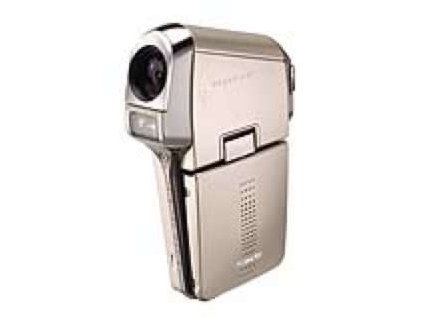TechRadar Verdict
A versatile device that's easy to carry around and fast to charge.
Pros
- +
Produces rich and detailed stills
Video is smooth and stable
Cons
- -
Puny microphone
Why you can trust TechRadar
Sanyo's Xacti VPC-C6 is the latest model since the range was launched in 2004. Now packing six megapixels and a raft of upgrades, the C6 looks better than ever. Its stylish silver steel casing and pistol-grip design (further reinforced with a smart black 'holster' case) definitely make it a head-turner.
The 2-inch LCD flips out to the left, and your hand curls around the body. The thumb reach needed to access the controls is a slightly unnatural stretch, and as always with this style camera, your forefinger will annoyingly want to plonk itself over the lens.
All the main controls are on the back spine, including the lens rocker, record/play selector, menu button and scrolling toggle switch that navigates the menu options. Then there are the two shutter buttons - one takes stills and grabs single image frames from video while clips are being taken, while the other is a dedicated movie-taking trigger.
The power switch is hidden away neatly under the LCD screen flap that also houses a speaker, and Sanyo has also managed to cleverly work the microphone into a raised circular panel on the camera's right flank. Worthy of a mention (because it's invisible) is the 5x optical zoom that's ingeniously packed inside the body.
The two screens of menus in playback and record cover both stills and video modes; they're slightly fiddly to use, but no more so than a mobile phone.
Six megapixels
The 'record' options cover picture quality and compression choices or bit-rates for both video and stills. Best quality video starts at 640x480 and captures at 30fps. We chose this for our tests, with 2,816 x 2,112 (6Mp high quality, low compression) for stills. There is a 10Mp option too, however this is an interpolated resolution, digitally enhanced from the 6Mp output.
Preset shooting modes were fairly standard, ranging from fully Auto to a Lamplight mode for birthday parties or candle-lit meals. Filters include skin tone enhancement, mono shooting and that all-time favourite: sepia.
Sign up for breaking news, reviews, opinion, top tech deals, and more.
Flash modes are simply Auto On or suppressed: there's no Red Eye mode, since Sanyo gives you the opportunity to edit out dreaded red eyes in post production using an in-camera editing tool. Happily, we never found red-eye to be an issue.
Image stabilising is important in a camera of this size and weight and there are a couple of options here to cope with video wobble and stills shake that can occur in low light shots; both were pushed to the limit, but just about coped.
The focus choices include a manual setting as well as the more immediate Auto Focus. It's arguable whether such a tool is needed because it's pretty difficult to tell whether anything's in perfect focus on a tiny 2-inch screen. It's controlled via an on-screen slider rather than a more satisfying lens-ring operation, which was fiddly and a nuisance. Having to go into the menu to find tools like focusing and exposure compensation takes time.
Focus is covered via a 5-point AF function, or Spot, and exposure metering is linked to this system; its performance was sometimes problematical. Image sensitivity in Auto defaults to ISO50 and can be upped to 400 - average for a camera of this calibre.
Things to consider...
Exposure metering was our only gripe. Even using the multi-patterned metering, skies could be 'burned out', while the rest of the image was fairly well-balanced. This was most evident in the video clips, where panning an image such as a boat moving along a canal resulted in wild fluctuations of lighting as the meter adapted itself. This doesn't occur in stills where the light meter isn't continuously searching, but it is common in lower-end, consumer video cameras.
For stills photography, we started simply metering for the sky to retain some detail, with the intention of underexposing buildings etc, in order to bring out the captured detail in these darkened areas with some post-editing.
Stills were good on the whole: while the exposure latitude wasn't great (there was also detail lost in the blacks and the shadows at the other end of the spectrum), for the most part images were clear and detailed (super macros were superb) with well-saturated colour, and the 5-point AF did its job well.
The C6 has its limitations for stills as well as for video clips. There's no video light so capturing moving footage at night is a nonstarter, but night-time stills are flashenhanced. Some functions are weighted more towards video than stills: for a portrait orientation to appear on screen, for example, the stills photographer has to manually select a 3Mp vertical pixel setting from the menu, or of course, turn the unit at right angles.
Sanyo deserves a round of applause for shoehorning two functions into such a small device, but given the results, it would be more attractive if the C6 was priced at about £50 less. The smooth playback of emailable, MPEG4 video clips, with passable sound and in-camera editing backed up by a fast response in standby mode, make the unit fun to use, and it's a great little gadget for spontaneous snapping when your more advanced compact or SLR is packed away.
Tech.co.uk was the former name of TechRadar.com. Its staff were at the forefront of the digital publishing revolution, and spearheaded the move to bring consumer technology journalism to its natural home – online. Many of the current TechRadar staff started life a Tech.co.uk staff writer, covering everything from the emerging smartphone market to the evolving market of personal computers. Think of it as the building blocks of the TechRadar you love today.
